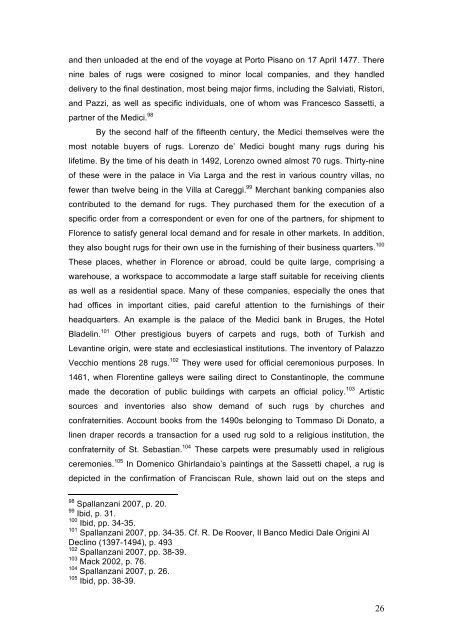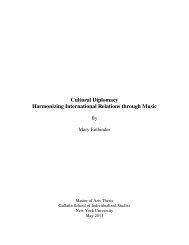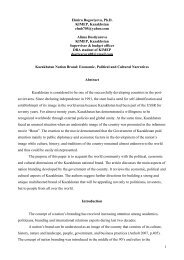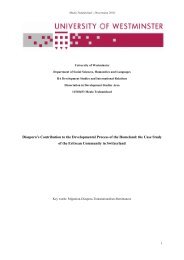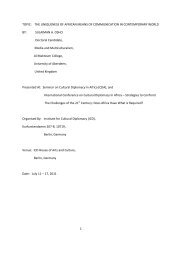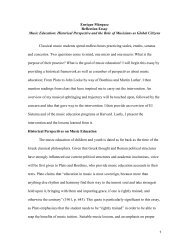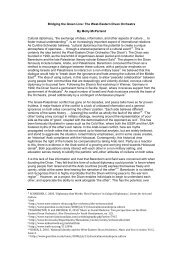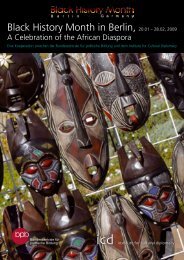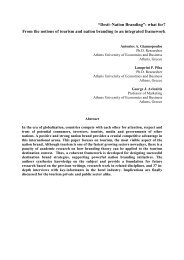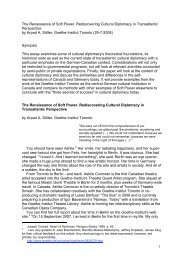Glass Bridges: Cross-Cultural Exchange between Florence and the ...
Glass Bridges: Cross-Cultural Exchange between Florence and the ...
Glass Bridges: Cross-Cultural Exchange between Florence and the ...
You also want an ePaper? Increase the reach of your titles
YUMPU automatically turns print PDFs into web optimized ePapers that Google loves.
<strong>and</strong> <strong>the</strong>n unloaded at <strong>the</strong> end of <strong>the</strong> voyage at Porto Pisano on 17 April 1477. There<br />
nine bales of rugs were cosigned to minor local companies, <strong>and</strong> <strong>the</strong>y h<strong>and</strong>led<br />
delivery to <strong>the</strong> final destination, most being major firms, including <strong>the</strong> Salviati, Ristori,<br />
<strong>and</strong> Pazzi, as well as specific individuals, one of whom was Francesco Sassetti, a<br />
partner of <strong>the</strong> Medici. 98<br />
By <strong>the</strong> second half of <strong>the</strong> fifteenth century, <strong>the</strong> Medici <strong>the</strong>mselves were <strong>the</strong><br />
most notable buyers of rugs. Lorenzo de’ Medici bought many rugs during his<br />
lifetime. By <strong>the</strong> time of his death in 1492, Lorenzo owned almost 70 rugs. Thirty-nine<br />
of <strong>the</strong>se were in <strong>the</strong> palace in Via Larga <strong>and</strong> <strong>the</strong> rest in various country villas, no<br />
fewer than twelve being in <strong>the</strong> Villa at Careggi. 99 Merchant banking companies also<br />
contributed to <strong>the</strong> dem<strong>and</strong> for rugs. They purchased <strong>the</strong>m for <strong>the</strong> execution of a<br />
specific order from a correspondent or even for one of <strong>the</strong> partners, for shipment to<br />
<strong>Florence</strong> to satisfy general local dem<strong>and</strong> <strong>and</strong> for resale in o<strong>the</strong>r markets. In addition,<br />
<strong>the</strong>y also bought rugs for <strong>the</strong>ir own use in <strong>the</strong> furnishing of <strong>the</strong>ir business quarters. 100<br />
These places, whe<strong>the</strong>r in <strong>Florence</strong> or abroad, could be quite large, comprising a<br />
warehouse, a workspace to accommodate a large staff suitable for receiving clients<br />
as well as a residential space. Many of <strong>the</strong>se companies, especially <strong>the</strong> ones that<br />
had offices in important cities, paid careful attention to <strong>the</strong> furnishings of <strong>the</strong>ir<br />
headquarters. An example is <strong>the</strong> palace of <strong>the</strong> Medici bank in Bruges, <strong>the</strong> Hotel<br />
Bladelin. 101 O<strong>the</strong>r prestigious buyers of carpets <strong>and</strong> rugs, both of Turkish <strong>and</strong><br />
Levantine origin, were state <strong>and</strong> ecclesiastical institutions. The inventory of Palazzo<br />
Vecchio mentions 28 rugs. 102 They were used for official ceremonious purposes. In<br />
1461, when Florentine galleys were sailing direct to Constantinople, <strong>the</strong> commune<br />
made <strong>the</strong> decoration of public buildings with carpets an official policy. 103 Artistic<br />
sources <strong>and</strong> inventories also show dem<strong>and</strong> of such rugs by churches <strong>and</strong><br />
confraternities. Account books from <strong>the</strong> 1490s belonging to Tommaso Di Donato, a<br />
linen draper records a transaction for a used rug sold to a religious institution, <strong>the</strong><br />
confraternity of St. Sebastian. 104 These carpets were presumably used in religious<br />
ceremonies. 105 In Domenico Ghirl<strong>and</strong>aio’s paintings at <strong>the</strong> Sassetti chapel, a rug is<br />
depicted in <strong>the</strong> confirmation of Franciscan Rule, shown laid out on <strong>the</strong> steps <strong>and</strong><br />
98<br />
Spallanzani 2007, p. 20.<br />
99<br />
Ibid, p. 31.<br />
100<br />
Ibid, pp. 34-35.<br />
101<br />
Spallanzani 2007, pp. 34-35. Cf. R. De Roover, Il Banco Medici Dale Origini Al<br />
Declino (1397-1494), p. 493<br />
102 Spallanzani 2007, pp. 38-39.<br />
103 Mack 2002, p. 76.<br />
104 Spallanzani 2007, p. 26.<br />
105 Ibid, pp. 38-39.<br />
26


